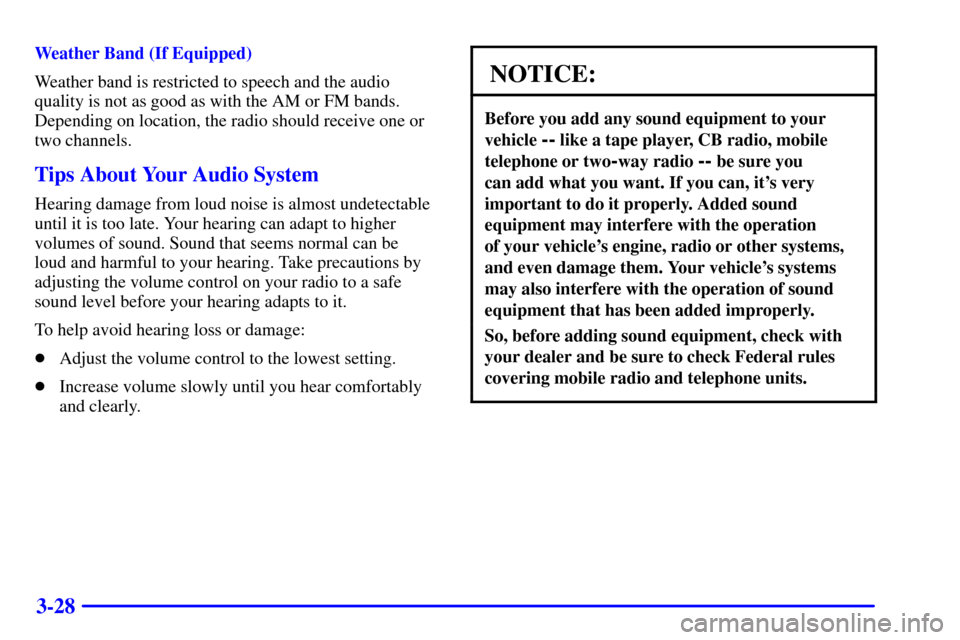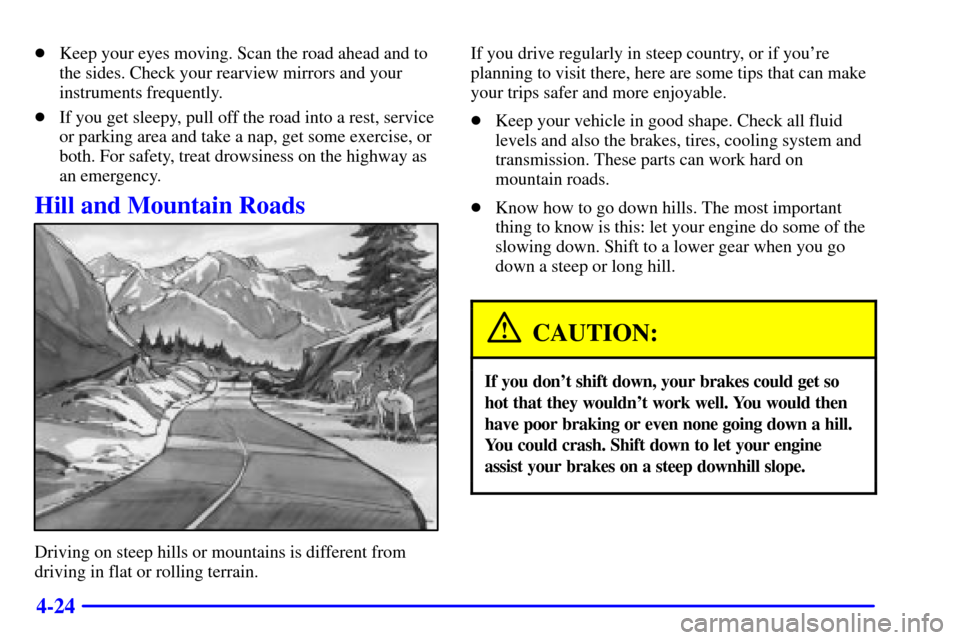Page 140 of 321
2-75 Oil Pressure Light/Gage
The light and gage tell you if there could be a problem
with the engine oil pressure.
United States Canada
The gage shows the engine oil pressure in pounds per
square inch (psi). Canadian vehicles show pressure
in kilopascals (kPa).
The oil light goes on when
you turn the key to ON or
START. It goes off once
you start the engine. That's
a check to be sure the
light works.
If it doesn't come on, be sure to have it fixed so it will
be there to warn you if something goes wrong.
When the light comes on and stays on, it means
that oil isn't flowing through the engine properly. You
could be low on oil and you might have some other
system problem.
CAUTION:
Don't keep driving if the oil pressure is low.
If you do, your engine can become so hot that
it catches fire. You or others could be burned.
Check your oil as soon as possible and have your
vehicle serviced.
Page 141 of 321
2-76
NOTICE:
Damage to your engine from neglected oil
problems can be costly and is not covered by
your warranty.
Check Oil Light
This light will come on for
a few seconds when the
ignition is turned on. If the
light doesn't come on, have
it repaired.
If the light comes on while starting and stays on for about
one minute or comes on while driving, the engine oil level
should be checked. Prior to checking the oil level, be sure
your vehicle has been shut off for several minutes and is
on a level surface. Check the oil level and bring it to the
proper level. See ªEngine Oilº in the Index.
Brake To Shift Light
This light will come on to
remind you that you must
press the brake pedal to
shift out of PARK (P).
Cruise Control Light
This light comes on
whenever you set your
vehicle's cruise control.
Page 143 of 321
2-78 Low Fuel Light
If the fuel level is low,
approximately one (3.8 L)
to two gallons (7.57 L) of
fuel remaining in the fuel
tank, a light will come on
until you add fuel.
The light may begin to flash as the fuel level gets lower.
It will also come on for a few seconds when you first
turn on the ignition as a check to show it's working.
If it doesn't come on then, have it fixed.
Fuel Cap Indicator Light
This light will come on
if the fuel cap has not
been fully tightened, is
missing or has been
improperly installed.
You should recheck your fuel cap to make sure it
is on tight.
If you continue to drive with a loose fuel cap, the
diagnostic system in your vehicle can determine if the
fuel cap has been left off or improperly installed. A
loose or missing fuel cap will allow fuel to evaporate
into the atmosphere. If this happens, the CHECK
ENGINE light may come on. For more information, see
ªMalfunction Indicator Lampº earlier in this section.
Page 149 of 321

3-5
DEFROST: Press this button to quickly remove
fog or frost from the windshield (the blower works in
high
-speed). This setting sends most of the airflow to the
windshield with only a small amount to the floor outlets.
FAN SPEEDS: Press the driver's side
TEMP/AUTO knob to set the fan speed for AUTO.
At this setting, the fan speed is automatically controlled.
If it is cold outside, the blower may not run in the
maximum high fan speed right away. The system checks
the temperature of the engine coolant to assure it is warm
enough to provide heat. When the engine coolant is
warm, the controller allows the fan to gradually increase
to a higher speed. This prevents cold air from blowing
into the passenger compartment. If you want the blower
fan at a high speed, press the up arrow button until you
reach the highest position of the display. If you want the
blower fan at a low speed, press the down arrow button
until the lowest position is displayed.
ON/OFF: Press this button to turn the system off.
Press this button again to turn the system back on.
Turning the climate control system on in this way
will recall all previous manually set mode settings. If the system is turned on by pushing the driver's
TEMP/AUTO knob for automatic operation, all of the
previous manually set mode settings will be changed
back to the fully automatic mode.
AC: Press this button to turn the air conditioning on
and off. The system will cool and dehumidify the air
inside the vehicle. In the automatic operation mode,
the display will show AC OFF when the air conditioning
has been turned off.
RECIRCULATION: Press this button to limit the
amount of fresh air entering your vehicle. This is helpful
to limit odors entering your vehicle. In the automatic
operation mode, the system will use recirculation as
necessary to cool the air. Pressing the recirculation
button will change the operation to a manual mode
and the air will recirculate non
-stop. Press this button
again to turn off the recirculation feature.
If you notice the windows fogging, press the
recirculation button to exit the recirculation mode.
Page 172 of 321

3-28
Weather Band (If Equipped)
Weather band is restricted to speech and the audio
quality is not as good as with the AM or FM bands.
Depending on location, the radio should receive one or
two channels.
Tips About Your Audio System
Hearing damage from loud noise is almost undetectable
until it is too late. Your hearing can adapt to higher
volumes of sound. Sound that seems normal can be
loud and harmful to your hearing. Take precautions by
adjusting the volume control on your radio to a safe
sound level before your hearing adapts to it.
To help avoid hearing loss or damage:
�Adjust the volume control to the lowest setting.
�Increase volume slowly until you hear comfortably
and clearly.
NOTICE:
Before you add any sound equipment to your
vehicle
-- like a tape player, CB radio, mobile
telephone or two
-way radio -- be sure you
can add what you want. If you can, it's very
important to do it properly. Added sound
equipment may interfere with the operation
of your vehicle's engine, radio or other systems,
and even damage them. Your vehicle's systems
may also interfere with the operation of sound
equipment that has been added improperly.
So, before adding sound equipment, check with
your dealer and be sure to check Federal rules
covering mobile radio and telephone units.
Page 182 of 321

4-7
Avoid needless heavy braking. Some people drive in
spurts
-- heavy acceleration followed by heavy
braking
-- rather than keeping pace with traffic.
This is a mistake. Your brakes may not have time to
cool between hard stops. Your brakes will wear out
much faster if you do a lot of heavy braking. If you
keep pace with the traffic and allow realistic following
distances, you will eliminate a lot of unnecessary
braking. That means better braking and longer
brake life.
If your engine ever stops while you're driving, brake
normally but don't pump your brakes. If you do, the
pedal may get harder to push down. If your engine
stops, you will still have some power brake assist. But
you will use it when you brake. Once the power assist is
used up, it may take longer to stop and the brake pedal
will be harder to push.
Anti-Lock Brakes (ABS)
Your vehicle has anti-lock brakes (ABS). ABS is an
advanced electronic braking system that will help
prevent a braking skid.
When you start your engine and begin to drive away,
your anti
-lock brake system will check itself. You may
hear a momentary motor or clicking noise while this test
is going on, and you may even notice that your brake
pedal moves a little. This is normal.
If there's a problem with
the anti
-lock brake system,
this warning light will stay
on. See ªAnti
-Lock Brake
System Warning Lightº
in the Index.
Page 198 of 321

4-23
The exit speed is usually posted.
Reduce your speed according to your speedometer, not
to your sense of motion. After driving for any distance
at higher speeds, you may tend to think you are going
slower than you actually are.
Before Leaving on a Long Trip
Make sure you're ready. Try to be well rested. If you
must start when you're not fresh
-- such as after a day's
work
-- don't plan to make too many miles that first part
of the journey. Wear comfortable clothing and shoes you
can easily drive in.
Is your vehicle ready for a long trip? If you keep it
serviced and maintained, it's ready to go. If it needs
service, have it done before starting out. Of course,
you'll find experienced and able service experts in
Catera dealerships all across North America.
They'll be ready and willing to help if you need it.
Here are some things you can check before a trip:
�Windshield Washer Fluid: Is the reservoir full?
Are all windows clean inside and outside?
�Wiper Blades: Are they in good shape?
�Fuel, Engine Oil, Other Fluids: Have you checked
all levels?
�Lamps: Are they all working? Are the lenses clean?�Tires: They are vitally important to a safe,
trouble
-free trip. Is the tread good enough for
long
-distance driving? Are the tires all inflated to
the recommended pressure?
�Weather Forecasts: What's the weather outlook
along your route? Should you delay your trip a short
time to avoid a major storm system?
�Maps: Do you have up
-to-date maps?
Highway Hypnosis
Is there actually such a condition as ªhighway hypnosisº?
Or is it just plain falling asleep at the wheel? Call it
highway hypnosis, lack of awareness, or whatever.
There is something about an easy stretch of road with the
same scenery, along with the hum of the tires on the road,
the drone of the engine, and the rush of the wind against
the vehicle that can make you sleepy. Don't let it happen
to you! If it does, your vehicle can leave the road in less
than a second, and you could crash and be injured.
What can you do about highway hypnosis?
First, be aware that it can happen.
Then here are some tips:
�Make sure your vehicle is well ventilated, with a
comfortably cool interior.
Page 199 of 321

4-24
�Keep your eyes moving. Scan the road ahead and to
the sides. Check your rearview mirrors and your
instruments frequently.
�If you get sleepy, pull off the road into a rest, service
or parking area and take a nap, get some exercise, or
both. For safety, treat drowsiness on the highway as
an emergency.
Hill and Mountain Roads
Driving on steep hills or mountains is different from
driving in flat or rolling terrain.If you drive regularly in steep country, or if you're
planning to visit there, here are some tips that can make
your trips safer and more enjoyable.
�Keep your vehicle in good shape. Check all fluid
levels and also the brakes, tires, cooling system and
transmission. These parts can work hard on
mountain roads.
�Know how to go down hills. The most important
thing to know is this: let your engine do some of the
slowing down. Shift to a lower gear when you go
down a steep or long hill.
CAUTION:
If you don't shift down, your brakes could get so
hot that they wouldn't work well. You would then
have poor braking or even none going down a hill.
You could crash. Shift down to let your engine
assist your brakes on a steep downhill slope.